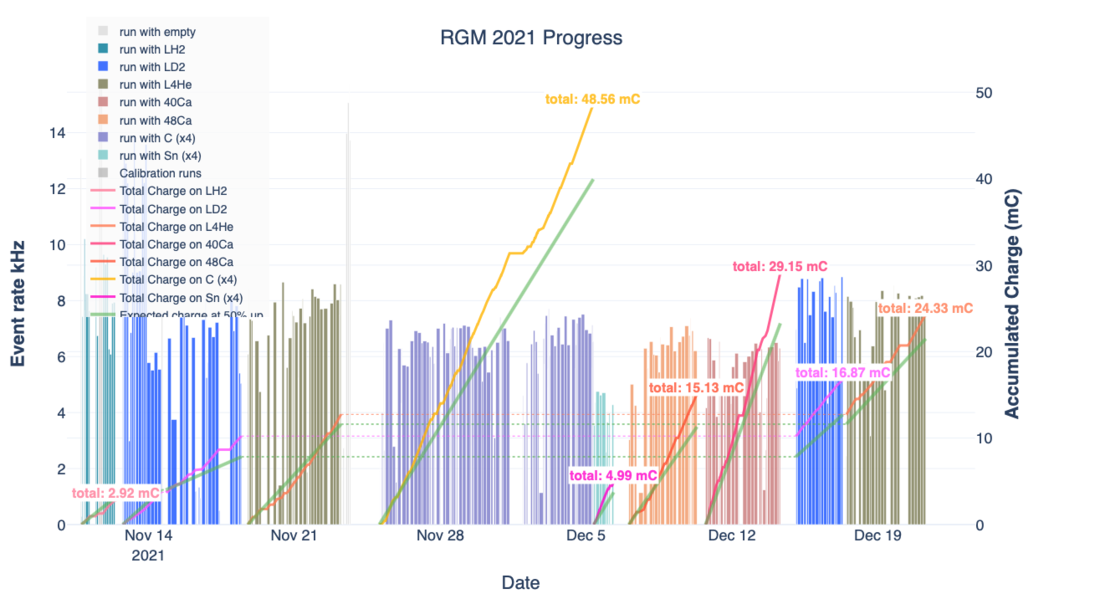Run Group M
Shift ScheduleESAD, COO, RSADShift ChecklistHot CheckoutBeam Time Accounting
|
Manuals |
Procedures |
JLab Logbooks
|
If calling local numbers (with area code prefix 757) from the counting room dial 9+[last 7 digits]. To call other area codes dial 91+[ten digit number]
|
| |||||||||||||||||||||||||||||||||||||||||||||||||||||||||||||||||||||||||||||||||||||||||||||||
- Note, all non-JLab numbers must be dialed with an area code. When calling from a counting-house landline, dial "9" first.
- To call JLab phones from outside the lab, all 4-digit numbers must be preceded by 757-269
- Click Here to edit Phone Numbers. Note, you then also have to edit the current page to force a refresh.
Click Here to edit Phone Numbers. Note, you then also have to edit the current page to force a refresh.
CLAS12 Run Group M, Fall 2021
Beam energies: 2.1, 4.0, 6.0 GeV (1.96 GeV/pass)
Important: Document all your work in the logbook!
RC: Sebastian Kuhn / Susan Schadmand
- (757) 575-7540
- 9 575 7540 from Counting Room
- hauenst@jlab.org
PDL: Valery Kubarovsky
- (757) 876-1789
- 9 876-1789 from Counting Room
- vpk@jlab.org
Run Plan: Jan 26 - Jan 30 2022
Production runs use PROD67_noVTPread and the trigger rgm_6GeV_inb_v1_0.trg .
Run duration 100M events or 4 hours, whichever comes first.
Summary
- Get Beam (pass2, 4 GeV beam)
- harp scans
- target centering)
- if BEFORE 9pm:
- fill Ar target
- luminosity scan - increase downstream halo FSD threshold, if needed
- beam blocker calibration (during day)
- run for 2 days
- if AFTER 9pm:
- insert C target
- decide 80 or 90 nA
- beam blocker calibration
- run 12 hours
- switch to Ar (2 days)
- switch back to C
- Sunday witch to LH2
- take C data while purging ?
- 1 shift LH2
- beam blocker calibration
- 4 hours empty target
- Monday pass change (6GeV beam)
|
DAQ configuration PROD67_noVTPread , production trigger rgm_2GeV_out_No_Dc_Roads_v1.1.trg / At the end of each run, follow the STANDARD DAQ RESTART SEQUENCE
Announcements
The integrated rates on the upstream counters have to be in the range 0-15 Hz (rates up to 100 Hz are acceptable) and the rates on the midstream counters have to be in the range 10-20 Hz (acceptable up to 50 Hz) @50 nA. Counting rates in the range of hundreds of Hz may indicate a bad beam tune or bleed-through from other Halls.
References and Standards:(last update 01/18/2022- 23:30 Nominal Beam Positions
FSD Thresholds
Reference Harp Scans for Beam on Faraday Cup: 2H01 [1] Reference Harp Scans for Beam on Tagger dump: 2C21 [2], tagger harp [3] Reference Monitoring Histograms (6 nA, production C) [4] Old reference Monitoring Histograms (50 nA, production LD2) [5] Counter rates
Beamline vacuum: should be not higher than 5e-5.
|
General Instructions:
Note that the dome lights when switched off cannot be turned back on immediately because they require 10-15 min to cool down.
Every Shift:
Log screenshots of: (this is for the remote shifter, see dedicated Remote Shifts tab above.)
In case of other questions or uncertainties of what to do, call the RC or PDL |
Webcams
|
Manuals |
Hall Webcams |
Epics on the web
|
Live Monitoring Links
|
|
|
Overview
Tasks
|
| ||||||||||||||||||
Hall-B
Run lists |
AcceleratorReferences |
ZOOM meetings
|

